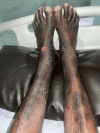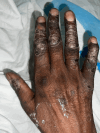Methotrexate Toxicity-Induced Pancytopenia and Mucocutaneous Ulcerations in Psoriasis
- PMID: 39238709
- PMCID: PMC11374579
- DOI: 10.7759/cureus.66222
Methotrexate Toxicity-Induced Pancytopenia and Mucocutaneous Ulcerations in Psoriasis
Abstract
Methotrexate (MTX) is a commonly used immunosuppressant and chemotherapeutic agent, widely prescribed for autoimmune diseases such as psoriasis, rheumatoid arthritis, and certain malignancies. It functions by inhibiting dihydrofolate reductase, leading to impaired DNA synthesis and cell proliferation. While generally well-tolerated, MTX has a narrow therapeutic index, and its adverse effects can be severe, including hepatotoxicity, pulmonary toxicity, and hematological complications such as pancytopenia. Pancytopenia involves the reduction of all three blood cell lines and can result in significant morbidity and mortality. The risk of MTX toxicity is notably higher in patients with renal impairment, as the kidneys are the primary route of drug excretion. Renal dysfunction can lead to the accumulation of MTX, enhancing its toxicity. Numerous studies and case reports have highlighted the risks of MTX toxicity, especially in patients with renal impairment. Pancytopenia can present insidiously, with symptoms such as mucosal ulcers, fever, and generalized weakness, making early detection crucial. We report a case of a male patient in his late 40s with a complex medical history, including psoriasis, insulin-dependent type 2 diabetes mellitus, chronic kidney disease (CKD) stage 3b, and coronary artery disease (CAD). The patient presented to the emergency department with a one-week history of fever, generalized weakness, mouth sores, and a five-day history of bilateral lower limb swelling and pain. Vital signs were stable, but physical examination revealed pallor, large ulcerative lesions in the buccal mucosa, and erythematous, scaly lesions on the lower limbs. The patient's medication history included methotrexate, which he had stopped two months prior but was inadvertently resumed at an increased dose two weeks prior to presentation. Laboratory findings revealed pancytopenia with worsening trends, prompting a bone marrow biopsy that showed hypocellular marrow. The patient's CKD likely exacerbated the MTX toxicity due to impaired drug clearance, leading to pancytopenia. Treatment included intravenous leucovorin, blood and platelet transfusions, and granulocyte-macrophage colony-stimulating factor (GM-CSF). Despite initial critical presentation, the patient showed significant improvement, with recovery of blood counts and resolution of symptoms. He was discharged with stable hemoglobin, platelet, and white blood cell counts.
Keywords: chronic kidney disease (ckd); folinic acid rescue; methotrexate toxicity; methotrexate-induced pancytopenia; plaque psoriasis.
Copyright © 2024, Surapaneni et al.
Conflict of interest statement
Human subjects: All authors have confirmed that this study did not involve human participants or tissue. Conflicts of interest: In compliance with the ICMJE uniform disclosure form, all authors declare the following: Payment/services info: All authors have declared that no financial support was received from any organization for the submitted work. Financial relationships: All authors have declared that they have no financial relationships at present or within the previous three years with any organizations that might have an interest in the submitted work. Other relationships: All authors have declared that there are no other relationships or activities that could appear to have influenced the submitted work.
Figures




References
-
- Methotrexate for psoriasis. da Silva CA, Von Kossel K, Leszczynski M, Melnik T, Riera R. https://doi.org/10.1002/14651858.CD010498.pub2. Cochrane Database Syst Rev. 2019;2019:0.
-
- Psoriasis--recent advances in understanding its pathogenesis and treatment. Krueger G, Ellis CN. https://doi.org/10.1016/j.jaad.2005.04.035. J Am Acad Dermatol. 2005;53:0–100. - PubMed
-
- Methotrexate for psoriasis. Boffa MJ, Chalmers RJ. https://doi.org/10.1111/j.1365-2230.1996.tb00142.x. Clin Exp Dermatol. 1996;21:399–408. - PubMed
-
- Guidelines of care for the management of psoriasis and psoriatic arthritis: Section 1. Overview of psoriasis and guidelines of care for the treatment of psoriasis with biologics. Menter A, Gottlieb A, Feldman SR, et al. https://doi.org/10.1016/j.jaad.2008.02.039. J Am Acad Dermatol. 2008;58:826–850. - PubMed
-
- Erosion of psoriatic plaques: an early sign of methotrexate toxicity. Pearce HP, Wilson BB. https://doi.org/10.1016/s0190-9622(96)90097-3. J Am Acad Dermatol. 1996;35:835–838. - PubMed
Publication types
LinkOut - more resources
Full Text Sources
Miscellaneous
